Biology For Class X - Chapter No. 2 - Homeostasis - Long Question Answers
GO TO INDEX
CHAPTER 2: HOMEOSTASIS
C. Extensive Response Questions And Notes
i) What is homeostasis and its important aspects .
Ans: Homeostasis:
Homeo means same and stasis means state.
So the regulatory mechanism which maintained the internal environment of an organism is called homeostasis.
OR
Homeostasis is set of metabolism which maintain internal environment of an organism within suitable limits.The internal conditions of an organism is referred its internal environment it includes H2O quantity, different solutes, temperature, etc. For proper metabolic functions body requires all these conditions at particular level.
Important Aspects of Homeostasis:
There are three important aspects of homeostasis.
-
a. Osmoregulation:
It is the maintenance of internal water and salt conditions by osmosis. - b. Thermoregulation:
It is the maintenance of temperature within suitable limits where enzymes can work properly (optimumly). - c. Excretion:
It is the process where metabolic toxic waste or excess metabolic substances (i.e NH3, urea or uric acid, gums, latex etc.) from body are removed.
ii) Define feedback system
Ans: FEED BACK SYSTEM:
The check and balance system in a body is called feed back system. In a feed back system three organs are involved.
- Receptor:
The organ which receive any change in the internal environment of the body. - Effector:
The central nervous system which send the message to a particular organ. - Central Nervous System:
The receptor transfer message to a central nervous system such as brain.
iii) Define Transpiration and Guttation OR Describe how extra water is removed from plants?
Ans: The plant store large amount of water this water can be removed from plant in two ways i.e.
(a) Transpiration
(b) Guttation
Transpiration:
It is the removal of water in the form of vapours from aerial part of plant. It occurs only at day time.
Plants modify their leaves size, structure and structure of stomata to control the rate of transpiration.
Guttation:
It is the removal of water in the form of liquid from the margin of leaves through special pores, hydathodes. It only occurs at night when water pressure is high in leaves and low temperature environment is present.
iv) Differentiate between transpiration and guttation.
Ans: Difference Between Transpiration And Guttation
| S.NO. | Transpiration | Guttation |
|---|---|---|
| 1. | It usually occurs during the day. | It usually occurs at night or early in the morning. |
| 2. | Water is given out in the form of water vapours. | Water is given out in the form of a liquid. |
| 3. | Several factors are responsible for this process. | This primarily occurs due to higher root pressure. |
| 4. | Water comes out in the pure form. | Water droplets consist of various organic and inorganic salts dissolved in them. So it is not pure. |
| 5. | It occurs through stomata, lenticels or cuticles. | It occurs through hydathodes only. |
| 6. | It is a controlled phenomenon. | It is an uncontrolled phenomenon. |
v) Define osmoregulation and discuss osmoregulation in plants in detail.
Ans: Definition Of Osmoregulation:
The regulatory mechanism which maintain the balance between water and solute context of a cell is called osmoregulation.
Osmoregulation in Plant:
Due to the availability of water and salt quantity there are four groups of plant.
- Hydrophyte
- Halophyte
- Xerophyte
- Mesophyte
Hydrophyte (hydro = water; phyta = plants):
The group of plant which grow in fresh water are called hydrophyte. They live completely or partially in fresh water so called totally or partially submerged plants. They adapt themselves for removal of excess water which can enter in this condition.
Characteristic of Hydrophyte
- The plant do not have layer of cuticle.
- They have broad leaves if partially submerged and have stomata in the upper surface (epidermis) to take part in transpiration.
- The root are either absent or poorly developed.
- They may have thin and spongy tissues in leaves and stem in totally submerged plant.
- Examples are Hydrilla, Lotus, Lily plant
Halophytes (Halos= salt):
The group of plant which grow in sea marshes or salty water are called halophyte. In salty condition water moves outside the cell which is not suitable for plants. To move water from outside to inside the plant develop following characters.
Characteristic of Halophyte
- They absorb water from the soil, which has higher salt concentration and low water potential.
- They actively absorb salt into their roots.
- Their leaves has salt glands which help in the removal of salt and water from the body, through active transport.
- Plants oppose salt to move outside from vacuole.
- Some halophytes absorb humidity by leave.
- Some salt accumulated at surface of leaf which attracts water from air.
- Examples are Glass wort, Cord grass
Mesophyte:
The group of plant which grow in well watered soil (or moderate water containing soil) are called Mesophyte.
Characteristics of Mesophyte:
- They have developed root system which do not grow very deep.
- Their body is covered by a layer called cuticle.
- They contain stomata for evaporation of extra water.
- They have moderate sized leaves.
- Some Mesophyte excrete out water in the form of drops ( guttation)
Xerophytes:
The group of plant which grow in dry places such as desert or soil of low water quantity are called Xerophyte. They grow in desert or steep slopes or at high altitude. To conserve water and absorb proper amount of H O they develop following characters.
Characteristic of Xerophyte:
- Their root are well develop which go deep into the soil to absorb water.
- Some plant have horizontal root on the surface to absorb rain water rapidly.
- They have short sized leaves or some plant leaves are modified into spine to prevent transpiration by reducing the number of stomata.
- Stem and leaves covered by thick waxy cuticles over epidermis to conserve water.
- Some plant store water in special parenchyma cells in stem, where they store water, this makes the stem soft, wet and juicy called succulent organ.
- Examples are Cactus, Euphorbia.
vi. Discuss Osmoregulation in animals in detail.
Ans: Osmoregulation In Animals:
Animals live in aquatic and terrestrial habitat. According to their environment their cells require critical balance of water and solutes. Water continuously leaves and enters the cells with solutes to keep the water and solute in constant quantity to ensure smooth metabolic functions.
Osmoregulation in Aquatic Environment:
Concentration of salt in water defines the aquatic conditions. The water which contains very low amount of salt is called fresh water and the water which contains high salt is called marine water. Animal osmoregulate differently in both waters.
i. Osmoregulation in fresh water:
Fresh water animals have hypertonic conditions inside their body or cells so they are always facing the problem of flooding of H20 and loss of salts. These animals are further classified in two groups.
-
Unicellular:
They pump out excess water by contractile vacuole.
e.g. Amoeba, Paramecium etc. - Multicellular:
They pump out excess water by producing dilute urine.
Loss of salt is compensated by active uptake of salt by gills and skin as well as use of salt containing food.
ii. Osmoregulation in marine animals
Marine animals have mostly hypotonic conditions (low salt) inside the body but some of them develop hypertonic (high salt) or isotonic (same salt condition) by metabolism. These animals are further classified as:
-
Bony Fish:
Have low salt inside the body.
Actively get sea water and have salt glands to increase the salt and desalination.
Produce concentrated urine. - Cartilaginous Fish:
Have high salt by storing urea inside.
Eat food which contain nitrogenous compound i.e. meat. - Osmoconformer:
Have equal amount of salt.
These animals do not require any activity to adjust their internal osmotic condition. i.e. unicellular.
iii. Osmoregulation in terrestrial condition:
In land animals excretion of water take place through body surface which leads to dehydration so they have developed number of strategies to maintain Osmoregulation.
Only arthropods, some molluscus reptiles, birds and mammals can survive in this habitat because:
- Their bodies are covered by exoskeleton or thick skin, which prevent loss of water.
- They conserve water by reabsorption in kidneys and rectum.
- Some of them can produce water from fats catabolism with the help of peroxysomes i.e. camel, kangaroos.
- Continuously drinking of water or using liquid food.
vii) What is Excretion?
Ans: Definition Of Excretion:
The removal of harmful substances produced in the metabolic process from the body is called Excretion.
Excretion in Plant:
In plant rate of catabolic process is very slow and waste products are produced in less amount. They are used again in their anabolic process. The substance which are produce in excess amount are Water, CO2 and O2 and ions.
- As autotrophs they synthesize variety of compounds, so the waste products of one reaction are utilized in other metabolic reactions as reactant and consumed.
- Excess water is removed by transpiration and guttation.
- Carbon dioxide and oxygen are removed through photosynthesis and respiration.
- Excess amount of ion are deposit into dead cell of plant body such as bark.
Excretion in Animal:
In animal removal of nitrogenous waste from the body is very essential. Animal have particular organ to excrete out nitrogenous waste. These organs are called excretory organs. There are different types of wastes in animals for which different excretory organs are used. The details are as follows:
viii) Explain Homeostasis in man.
Ans: HOMEOSTASIS IN MAN
Humans have a very well developed homeostasis system comprising of the following main organs:
- Skin
- Lungs
- Kidneys
(i) Skin:
The Skin is considered as an excretory organ because it excretes water, salt, and urea from the body through sweat. It is the largest organ of the body, which basically functions as a protective organ as the first line of defense but it also works efficiently as a homeostatic organ or excretory organ by maintaining temperature, water and salt.
(ii) Lungs:
Lungs are responsible for maintaining levels of O2 and CO2 in the blood, body fluid and cells in order to maintain the rate of respiration and continuous flow of energy.
(iii) Kidneys:
Kidneys are called filters of the body fluids, they maintain internal water by removing excessive water, also maintain urea, uric acids, creatinine and other waste by excreting them through urine.
ix) Explain the structure of Human skin in detail with labelled diagram. Also discuss the role of skin in regulating body temperature Or How skin works as thermoregulatory organ??
Ans: STRUCTURE OF SKIN:
Human skin is comprised of three layers ,namely, epidermis, dermis and hypodermis.
Epidermis:
- Epidermis is the outer most layer which is made up of flat, dead cells containing keratin protein.
- It is an impermeable layer and thus prevents loss of water from the body.
- It does not contain blood vessels.
- It prevents the entry of micro organisms.
Dermis:
Dermis is the layer present between epidermis and hypodermis, it contains many different structures. They are as follows:
- Dermis has nerves ending receptors to detect temperature change, pain, pressure etc.
- It also contains sweat glands which secrete sweat on the surface to maintain temperature and also secrete urea, water and salt.
- A network of arterioles are also present in the form of network, which are involved in temperature regulation.
- The dermis also contain hair follicle and sebaceous glands which secrete oily sebum.
Hypodermis:
- It is the inner most layer of skin.
- It contains fats which act as insulation against loss of heat.
- It also stores energy.
Role of Skin in Regulating Body Temperature OR Skin Works As Thermoregulatory Organ:
The skin is the organ which help in regulating body temperature . The receptors in skin send nerve impulse to brain in case of increase or decrease in temperature.
If Body Temperature Start Rising when it is hot:
- Production of sweat:
The sweat gland starts to produce and secrete sweat which accumulates at the surface of skin and evaporates with heat energy so the body starts feeling cool. - Laying down of hairs:
In hot condition, muscles attached to hair, relax and allow the hair to lie flat against surface of the skin. - Vasodilation:
Arterioles in dermis, dilate increasing the flow of blood, This dilation brings the blood vessels near the surface of skin allowing more heat loss. This process of vessel dilation is called vasodilation.
Role of skin in cold condition:
In cold condition when the body temperature starts decreasing the skin maintains the temperature by following actions:
- Erection of hairs:
The muscles contract pulling the hairs upright and trapping a layer of insulating air next to skin. - Vasocontraction:
Narrowing of blood arterioles of dermis occur which reduces the blood flow in capillaries of skin so less heat is lost. - Decrease in sweat production:
The sweat gland stops to produce and secrete sweat, in order to prevent energy loss. - Increase in metabolic rate:
In cold conditions the rate of metabolism in the organs increases generating more heat which is distributed around the body in the blood stream. It prevents loss through the adipose tissue in hypodermic which work as an insulation layer.
x. Explain and discuss the role of lungs in keeping the CO2 concentration low to certain level.
Ans: Tissues play a vital role in keeping the CO2 concentration low to a certain level through the following steps:
- A large amount of CO2 produced during the aerobic respiration is diffused into the blood where it forms carbonic acid after reacting with water.
- This reaction takes place by an enzyme called carbonic anhydrase present in R.B.C.
- The carbonic acid dissociate into H+ and bicarbonate ions. H-1CO3 ions.
- The level of H in blood is continuously monitored by special detectors (receptor) carotid bodies and aortic bodies.
- Most of the bicarbonate ions diffuse out from R.B.C to blood plasma.
- A small amount of CO2 is also carried and dissolved in R.B.C.
- when the blood reaches lungs these bicarbonate ions diffuse back into RBC where again converted into carbonic acid then into CO2. The CO2 diffuses out of the blood capillaries and into alveoli, from where it is expelled out when breathing out.
- If the CO2 level increases in blood, pH of blood start increasing so that the receptor send a message to the control centre which ultimately increase the breathing rate to expel out the CO 2 efficiently.
xi) What do you know about urinary system in man? Or Describe the urinary system of man with the help of diagram?
Ans: Urinary System In Man
Urinary system of man consist of:
- A pair of kidney
- A pair of ureters
- A urinary bladder
- A urethra
Kidneys:
- Kidneys are reddish-brown bean shaped organs, situated at the dorsal side of the abdominal cavity on either side of the vertebral column.
- The kidneys lie above the waistline.
- Each kidney has an area in the center of concave surface which faces the vertebral column; this area is called hillus.
- The renal artery, renal vein, nerve and ureter are connected to each kidney at the hillus.
- They are covered by a membrane are called peritoneum.
Ureter:
- The ureter is a narrow tube which connects the kidney to the urinary bladder.
- Urine passes through ureter to the urinary bladder.
Urinary Bladder:
- The urinary bladder is a thin walled muscular pear shaped bag situated towards the bottom of abdominal cavity in front of the rectum which stores urine.
Urethra:
- The urethra is a tube which comes out from the urinary bladder, runs down and opens outside the body through urinary opening.
- It passes urine from bladder to outside the body.
xii) Explain the structure and function of kidneys in detail with labelled diagram.
Structure Of Kidney:
- Kidney are a pair of dark red bean shaped structures which are attached to the dorsal wall of the abdominal cavity.
- It is enclosed in a membrane called peritoneum.
- Peritoneal fluid is present between the kidney and peritoneum to reduce friction.
Parts of Kidney:
A longitudinal section (L.S) of kidney consist of three main parts.
- The cortex
- The Medulla and
- The Pelvis
1. Cortex:
- Cortex is the outer and darker region.
- It is covered and protected by a fibrous capsule.
2. Medulla:
- Medulla is the inner and lighter region in the kidney.
- It contain many cone like structure called renal pyramids. The human Kidneys contain 12-16 pyramids.
- It also contain nephron which is the basic functional unit of kidney.
- Nephrons are tiny kidney tubules where osmoregulation occurs to produce urine.
3. Pelvis:
- Pelvis is the funnel like space.
- It is the enlarged portion of ureter inside the kidney.
- The kidneys are connected to the ureter at pelvis.
Functions Of Kidney:
- Kidney is an excretory organ. It removes excess mineral salts and nitrogenous waste products in the form of urine from the body.
- Kidney maintains osmoregulation and regulates water and salt balance in the blood.
- Kidneys makes sure that the concentration of blood stays more or less constant.
xiii) Describe the structure of Nephron? Or Describe the structure of nephron within the L.S of kidney.
Ans: Nephron:
The basic structural and functional unit of kidney are called Nephron. Each kidney contains more than one million nephrons, which are microscopic urinary tubules. Number of nephrons open into a tube called collecting duct.
Structure of Nephron:
Each nephron is sub-divided into four main parts:
- Bowmann's Capsule
- Proximal convoluted tubule
- Loop of Henle's
- Distal convoluted tubule
Bowmann's Capsule:
- In each nephron inner end forms a cup-shaped swelling called Bowmann's capsule.
- Each bowman's capsule have a ball of capillaries called glomerulus.
- Bowman capsule gives out a short coiled tubule called Proximal Convoluted Tubule which passes into the medulla.
- The
tubule enters into medulla, extends into renal pyramid and makes a U
shaped structure called loop of Henle and it goes back into cortex.
- The tubule becomes convoluted again after entering the cortex again.
xiv) Describe the network of blood vesseles in nephron and their functions.
Ans: Network And Functions of Blood Vessels In Nephron:
- Afferent Arteriole:
The renal artery when enters into kidney, it divides into millions of branches called afferent arteriole. The blood enters the kidney through renal artery and goes into afferent arteriole. - Glomerulus:
Each afferent arteriole further divides into numerous blood capillaries collectively called glomerulus. The Bowmann's capsule with glomerulus is called Malpighian body or renal corpuscles. - Efferent Arteriole:
Blood leaving the glomerulus through efferent arteriole, enter blood capillaries surrounding the nephrons. - Venule:
Blood capillaries surround a loop of Henle's unite to form venule, which ultimately joins to form a branch of renal vein.
xv) Discuss the role of Kidney in urine formation
Ans: Role Of Kidney In Urine Formation:
Urine formation takes place in the following steps:
Urea formation:
Urea is naturally produced with in the liver cells when the liver breaks down protein or amino acids, and ammonia. Liver is unable to store proteins. The extra amino acids break and gives energy but the amino group (-NH2) is removed by deamination and is converted into ammonia (NH3) which is very poisonous, it may kill the cell when stored in high concentration. So the liver cells quickly convert NH3 into less toxic substance urea. It is carried by blood to kidneys and excreted out in the form of urine. A small amount of urea is also excreted in sweat as well.
Urine formation:
The mixture of excessive mineral salts and nitrogenous waste products i.e. urea, creatinine and uric acid, mixed with water. This mixture is called urine. Urine is formed within the kidneys and the two main processes involved in its formation within nephrons, which are:
- Filtration
- Reabsorption
(i) Filtration:
The process of taking out materials from blood is called filtration . It is of two types:
- (a) Ultrafiltration
- (b) Selective filtration
(a) Ultrafiltration:
Filtration occurs at Para tabular capillaries (in Malphigian body) is referred to as Ultra filtration because most of the blood plasma is forced out of the glomerulus blood capillaries into Bowman's capsule without any selection. This is a Process of non-selective filtration.
(b) Selective filtration:
It occurs at proximal and distal convoluted tubules when blood flows into peritubular capillaries, the remaining amount of urea filters out from blood by active transport. It requires some energy.
(ii) Reabsorption:
A normal adult produces about 120 cm3 of filtrate in the kidney every minute which if passed out as urine from the body, the body will dehydrate and death can occur. When the filtrate passes through the nephron useful substances and excessive water are reabsorbed in blood stream to prevent this huge loss of water and useful salts.
Reabsorption can be:
- (a) Non-selective
- (b) Selective reabsorption
(a) Non-selective reabsorption:
It occurs at distal and proximal convoluted tubules without any selection.
(b) Selective reabsorption:
It occurs at Loop of Henle's and collecting duct with the help of hormones. i.e. Antidiuretic hormone (ADH), Parathyroid hormones (PTH) and calcitonin.
Role of kidneys in osmoregulation:
- The control of water and salt content of the body is known as osmoregulation.
- Kidney is not only an excretory organ, it also regulates water and salt balance in the blood.
- Sudden changes in the water potential of blood can lead to serious problems. For example if plasma becomes very dilute, water will enter the blood, cells will swell and possibly burst.
- On the other hand if the blood plasma becomes too concentrated, water will move out of the cell by osmosis, as a result of it the blood cells and tissues will become dehydrated and shrink.
- Kidney ensures that concentration of blood stays more or less constant.
xvi) Describe different disorders of kidney and their treatment?
Ans: Kidney Problems Or Disease:
When the kidneys do not function properly due to different reasons this is referred as Kidney problem or Kidney disease.
There are many problems of kidney:
- Kidney Stone
- Kidney Failure
Kidney Stone
- Stone solid materials found in the kidney called Kidney Stone.
- A kidney stone is a solid mass that forms from the crystals of calcium oxalate or Calcium Carbonate. Sometimes uric acid and cysteine are also present in it.
Causes:
- 70% of kidney stone are formed due to calcium oxalate and phosphate oxalate which are produced in metabolic process and are added in the urine and deposit in kidney change into stones.
- Oxalates are present in green vegetables and tomatoes therefore may be the source of oxalate stone.
- 20% stone are called as infective stone. Infective stone consist of combination of calcium, magnesium and ammonium phosphate.
- 5% stone are formed in uric acid.
Treatment:
- Lithotripsy:
The lithotripsy is used for nonsurgical removal of kidney stone. It is a technique used to break up stones that form in the kidney, ureter or gall bladder by ultra sonic waves. The broken down rudiments pass out of the body with urine without pain.
- Renal surgery:
Large stones are removed by surgery.
Prevention:
The large intake of water is the only measure to minimize the chances of formation of stone in kidney.
Kidney failure:
Sometimes the working of kidney is badly damaged because the nephrons stop working due to certain reason or infection and the kidneys are not able to filter the harmful nitrogenous substance it is called Renal failure Or Kidney failure. In such condition the harmful substance (urea and other waste materials) remain in blood. The amount of H2O is not regulated also. This dis-balance of solutes causes death ,therefore the treatment must be given to filter out wastes by machines.
Treatment of Kidney Failure:
-
Dialysis:
A dialysis machine performs the function of a kidney. It helps to clean the patient's blood from metabolic waste products and toxic. For effective treatment the patient needs to undergo dialysis 2-3 times a week. Each session lasts about 3-5 hours depending on the patient's body size and medical condition. - Kidney Transplant:
Dialysis may be used as temporary measure, if a kidney donor is not available.
In high degree renal failure the surgical transplantation of matching donor kidney is only the option left as the permanent treatment. A person with two healthy kidney may donate one kidney and survive with one kidney.





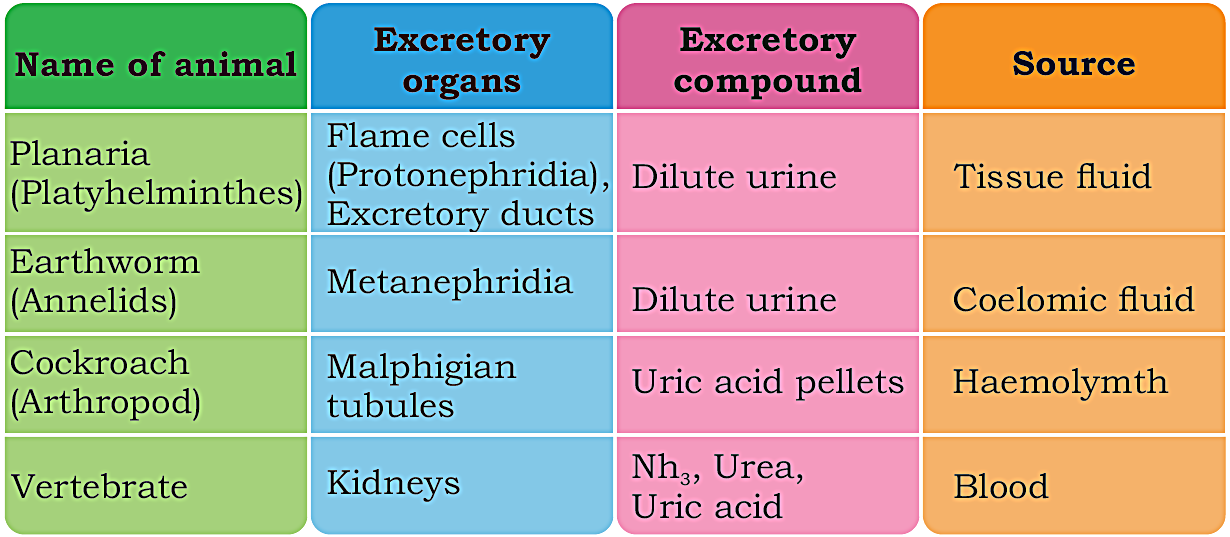





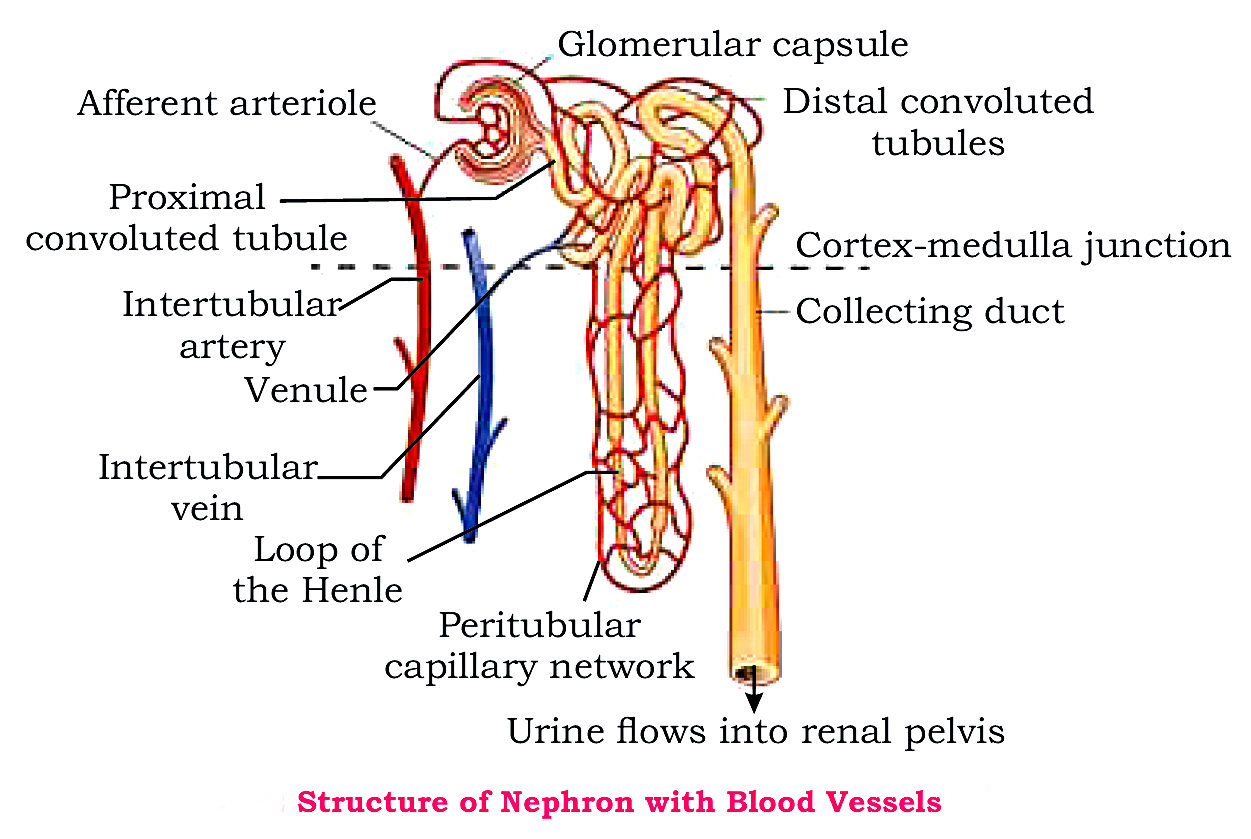
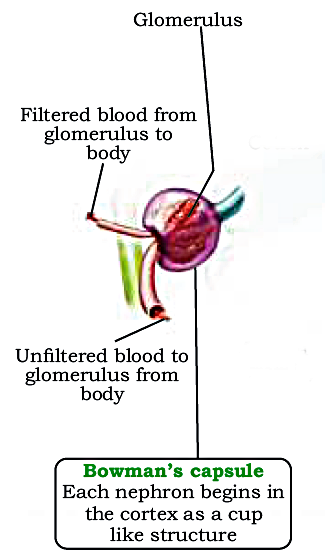


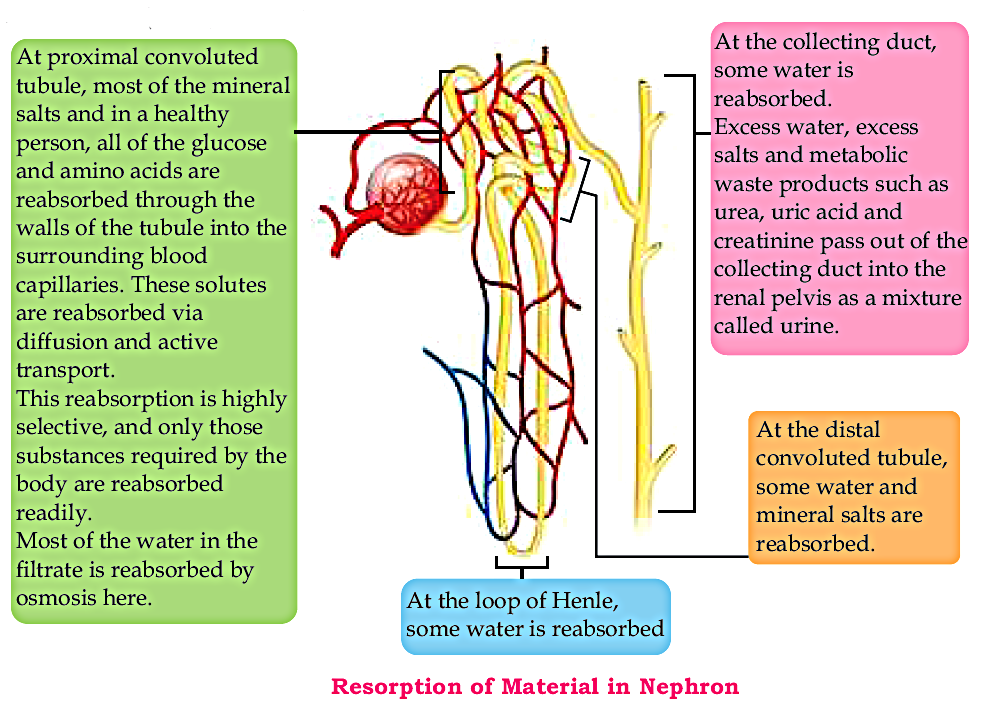
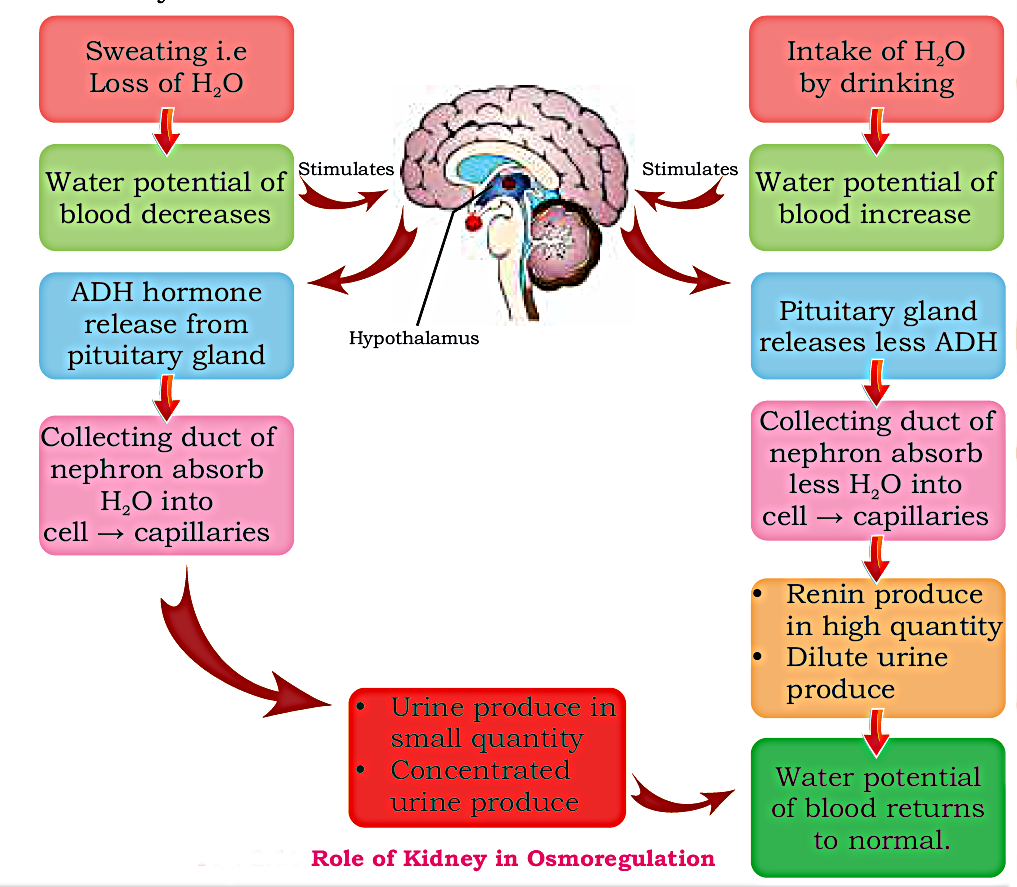






0 Comments